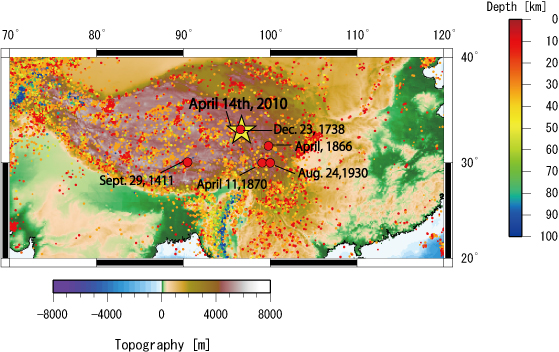Launched: April 14th, 2010
Updated: April 15th, 2010
According to USGS, an earthquake of magnitude 6.9 occurred in Yushu County, Yushu Tibetan Autonomous Prefecture in Qinghai Province, China at 8:49am, April 14, Japan time (Local time: 7:49am).
Following is a quick report of the event.
(Outreach and Public Relations Office)
[ Basic Information ]
- date and time: April 14th, 2010 at 8:49am Japan time (local time: 7:49am)
- location of epicenter: 33.27N, 96.63W, 10km deep (USGS)
- related plates: Indian and Eurasian plates (collision of continental plates)
- fault of epicenter: Yushu fault
- type of earthquake: strike-slip
[Tectonics Background]
This is the area where the Indian Plate collides against the Eurasian Plate, the plate where China is located, and tectonic deformations can be seen in the vast area of the Tibetan Plateau. This earthquake on April 14 is due to this collision.
When the oceanic and continental plates collide, such as in Japan, Indonesia and South America, the oceanic plate subducts under the continental plate. However, in cases where continental plates collide, neither of the plates subduct under the other, but creates a collision zone. Therefore, there is a lot of stress on the Tibetan Plateau which is the collision zone, and frequent earthquake activities are observed. (Figure 1)
Historical Earthquakes:
September 1411 (M8); December 1738 (M6.5); April 1870 (M7.3); August 1930 (5.5)
The 1738 earthquake occurred relatively close to the earthquake on April 14.

Figure 1: Epicenters of the past earthquakes from 1973 to March 2010. (Epicenter data reference: PDE catalog)
[Waveforms observed by J-array]
The new J-array earthquake waveform database uses the network to resemble a giant array and collects the seismogram realtime from all over the world and is put int o the database. At the moment, all three components of the waveform data from about 400 stations placed by universities and the JMA are collected through the high-speed ground network. Seismogram is sampled in 20Hz. transformed into and saved as J-array Standard Waveform Data.
Earthquake and Volcano Information Center